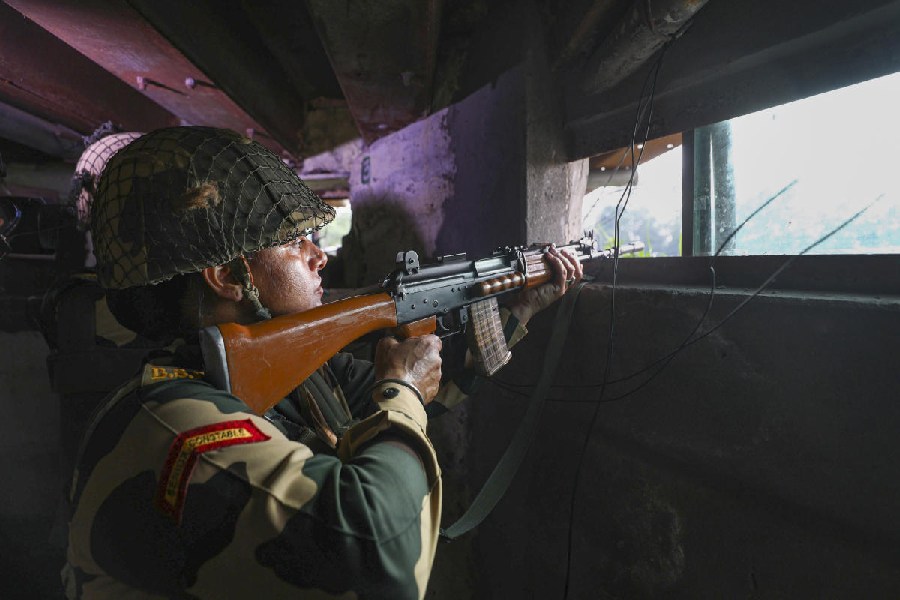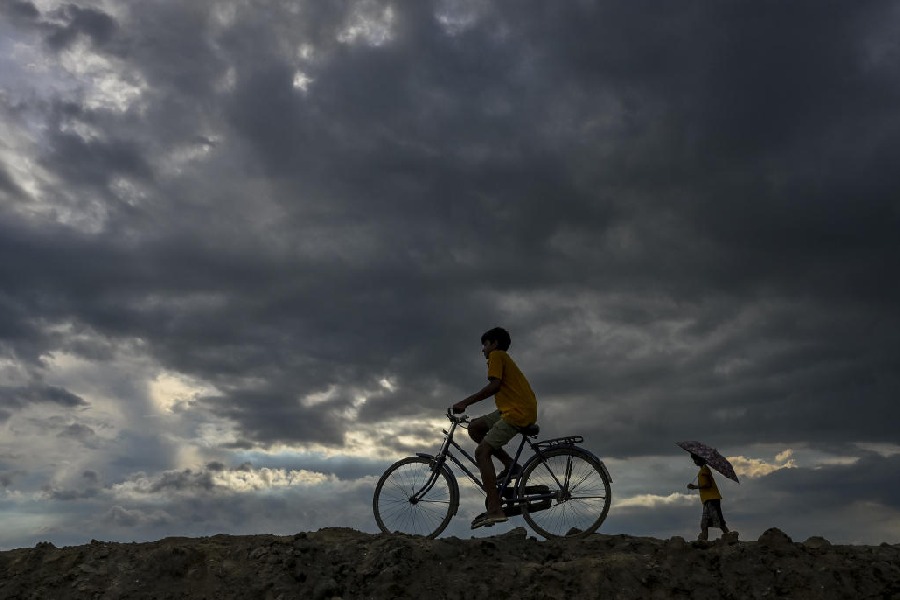


9am: We are still a few kilometres from the forests of Lalgarh in Jhargram, where the grand event would unfold. Thousands of people from the bush and surrounding villages would gather in Jangalmahal - the forested belt straddling Purulia, Bankura, West Midnapore and Birbhum. It is April 13, another day marked by tribals for a hunt.
Hunting is not a rare occasion in these parts. Only a few days ago - on March 27 - the additional divisional forest officer of Midnapore, Purabi Mahato, fell at the feet of Adivasi elders to dissuade them from going inside the forest. It might disturb the tiger, she had pleaded. Some hunters went back, but many others didn't.
A full-grown Royal Bengal tiger had strayed into these forests, but where from the authorities hadn't been able to ascertain. Camera traps installed by the WWF-India had confirmed the visitor's presence in early March. Subsequently, there were attempts to catch the big cat - in order to move it to a more suitable habitat - but in vain. Two guards even lost their lives in the line of duty, although their deaths were due to suffocation inside their car and not because the beast had mauled them.
9.20am: We are passing through the village of Pirakata. There is a lengthy procession of devotees. Most of them are children. They are balancing on their slender shoulders bamboo sticks with earthen pots hanging from either end.
Further down the road, flanked by fields, are a couple of open trucks, fitted with loudspeakers. They are playing Bambaiya filmi music. Groups of men, bright red and pink ribbons tied around their heads, are hanging around, enjoying the festive air. Their pots of sacred water peep out of the trucks. There are others riding bicycles with their holy contraptions. A little dilution in rituals and traditions never hurt anyone, after all.
9.45am: The metal road eventually gives way to a red one. An armed guard signals us to stop. He briefly surveys the inside of the car, while his two female associates sit under a neem tree a few metres away.
10am: We enter the forest. Deeper. Deeper. The more it closes in on us, the more we become aware of our diminutiveness. A different set of rules and equations play out in shades of green and brown, suffused with the humming of insects, each a pitch of its own. It is as though the scorching heat has turned on all the sounds and smells. The scent of eucalyptus sometimes spews about distinct, through the glowing sal. At least, there is not much dust... only small and big puddles on the brilliant red earth.
"These parts are khoni, khoni (treasure)," cries out Arabinda. He is part of the team of young conservationists visiting the forest. "The last time I was here, I saw the most beautiful sight - a pregnant wolf slinking away." Lalgarh's forests are still home to the wild boar, rabbit, fishing cat or baghrul, which is the state animal, the Bengal fox and others. But Arabinda knows that the organic alliances that make up this precious forestland are under serious threat. "The deer, pangolin and porcupine... shob shesh, wiped out," he laments.




Twenty minutes down the road, we spot the first hunter. He is past his prime but rugged and strong. In one hand he holds a borsha (spear fitted to a long, sturdy bamboo). An axe rests on his shoulder. The man is, however, in no mood to speak to strangers, or even acknowledge our presence as we stop the car and roll down the windows.
A few minutes away, in a small clearing, we come upon a hunting party. There are about 20-odd men, some sitting on a broken culvert. They haven't chanced upon a kill yet and speak with caution, as if not wanting to let out the secrets of the task in which they excel. Some of them are from Jhitka, a tiny hamlet on the forest outskirts; others are from villages further away. They are headed to Pakhibaand, where hunters from all directions are supposed to assemble after killing their trophy animals.
The name Pakhibaand brings to mind an image - a textbook image of an expanse of water with birds fluttering on top. Is it someplace where birds come down for a vacation? No one can tell. Not even Hembrom, the old man who waves at us for a lift. He is 86, has only one arm and is carrying an axe. But you don't look your age, I say. He replies: "I have three cows; the milk keeps me strong and able." And then proudly adds, "Today you will see what an Adivasi hunt is all about; come with me." And the missing hand? "I was shot at... years ago," he says. No further explanation offered.
A few empty vans rest along the bumpy path. The mud houses - with roofs of tin and asbestos - appear abandoned, with not a soul near them. Only the calls of a myriad birds ring about, as if to remind that they are watching.
Everyone is where the action is. The shikar utsab is a big draw - in spite of the strict laws against hunting - and even non-Adivasis of the area and those in far-off villages and towns participate in it.
10.30am: All along the way, there is no sign of any regulation. At Dherua village, the forest department's beat office is small and insignificant. "Sometimes the authorities put up barricades - simply, bamboo sticks thrown across the kuchcha path - that serve as a signal, however weak, for the incoming trucks and vans to stop. None of that seems to be in place today," rues Meghna Banerjee, a lawyer by profession and wildlife activist by passion. "I had intimated the additional principal chief conservator of forests about the event, and he had assured action would be taken," she adds.
A few days ago, the divisional forest officer of Midnapore, Rabindranath Saha, too had said that hunters come in from as far as Bankura and even neighbouring Odisha. "March 27 is part of their annual events calendar," Saha had said. "But in our eyes, it's hunting and prohibited by law... Efforts are on at various levels to bring change, more so at the interface of technological advancement and the younger generations."
Most wildlife conservationists, however, say that the efforts are not enough. "The number of hunting events has increased over the last many years, in a clear departure from the original calendar," points out Banerjee.
11.15am: Pakhibaand is an open-air stage teeming with people, who have turned it into a makeshift bazaar. Chopped sal branches have been dug into the dry ground and strung over with tarpaulin sheets to create patches of shade. Women are sitting under these with huge hindalium vessels full of handiya, the local brew. The air is thick with the pungent-sweet smell of fermentation. Some of it is in the final stage of preparation. "Khaabey?" asks a woman, laughing, as she squashes clods of rice and strains the liquid through a piece of cloth.
Some folks are frying alur chop, some selling bidis and biscuits, and yet others minding mounds of spicy gram and jhuri bhaja.
11am: Evidently, most of the crowd has gathered to cheer and partake of the spectacle. About a hundred metres away, through a wide crack in the earth, runs a trickle of muddy water. Some are scooping up the water in bowls and plastic cans.
“The hunters have spread in all directions,” says old man Hembrom. “They will be back here after they have got their kill. And then, you will not find even an inch of space to stand on,” he boasts. Later, we learnt that the turnout that day was over 10,000.
One of them, a particularly chatty 30-something, takes it upon himself to set out the happenings around us. “Our desi dogs are very smart,” he says, patting one that lies at his feet. He describes in detail how they make excellent watchdogs. “They also know exactly which (wild) hen to pounce on, but will never even get close to a boar.” Wild boars can be tough game, and can even kill a man. A couple of hunters injured themselves that day.
Our man continues. “I am a Muslim fellow. I have been driving a van for seven years now, bringing hunting parties to this place. Sometimes they pay me, sometimes they pay for the petrol,” he said. Then edging closer, adds, “We are such good friends, we can even die for each other.”
11.45am: We resume our trek. We are now going deeper into the jungle in search of the hunters and the hunted. Our young companions are determined to note as much as they can. To me, however, the sheer enormity of the arena is overpowering, and appears to render such efforts futile.
After an hour of dodging low hanging branches, frogs, geckos, nests of red ants and what not, I have given out very strong signals, to stop. Hereon, two members continue on their way, while three of us wait. I settle on the warm dry floor, in an effort to keep myself above water. The breeze is surprisingly cool in my face, perhaps because I know what the forest heat is like. In that concurrence of time, place and action only my sense of hearing seems to work, and how!
There is the distant but intermittent dhook dhook, which someone suggests is from a faraway sound box. There is an assortment of birdcalls — to warn, ridicule or entertain, I cannot tell. Then there is the sound of shuffling feet and hushed voices — hunters keeping an eye on us.
Phone connectivity is an idea under construction, and sustenance sips off a pale orange energy drink. When we stray from the set path, a sinister sound checks our steps — the sound of trees being chopped.
1.50pm: After about two long hours, we are back at Pakhibaand. By then the smell of handiya has grown much stronger and the buzz louder. Many of the revellers are lying on the ground, unable to move, but perhaps a big part of their being is in another realm.
The men are trooping in with the dead animals tied to their bows and arrows, spears and axes. As old man Hembrom had foretold, soon there will be no space for us.
“There is nothing that the jungle hasn’t given us,” says a man who has come from another village, with two others, on a bike. “Why should we be afraid of the jungle?”
Among the dead animals that day are 15 jungle cats, 30 boars and an equal number of rabbits.
3.30pm: We just about begin our return journey when we get the big news. The tiger has been killed. From the beat office at Dherua, where two uniformed guards lie on the grass in the shade of a magnificent tree, we speed in the other direction, towards Chandra village.
Earlier in the day, two hunters were injured when their paths crossed with the tiger’s.
The beast was killed by a group of hunters in Baghghora. When those men formed a circle around it and attacked it with spears, it was apparently enjoying a meal — a boar. And to think just then, we were only a few kilometres away.
Back in the car and heading home. Something growls making my companions start. I discreetly clutch the handbag closer to my stomach. Which too is growling with hunger. Such a long journey.










